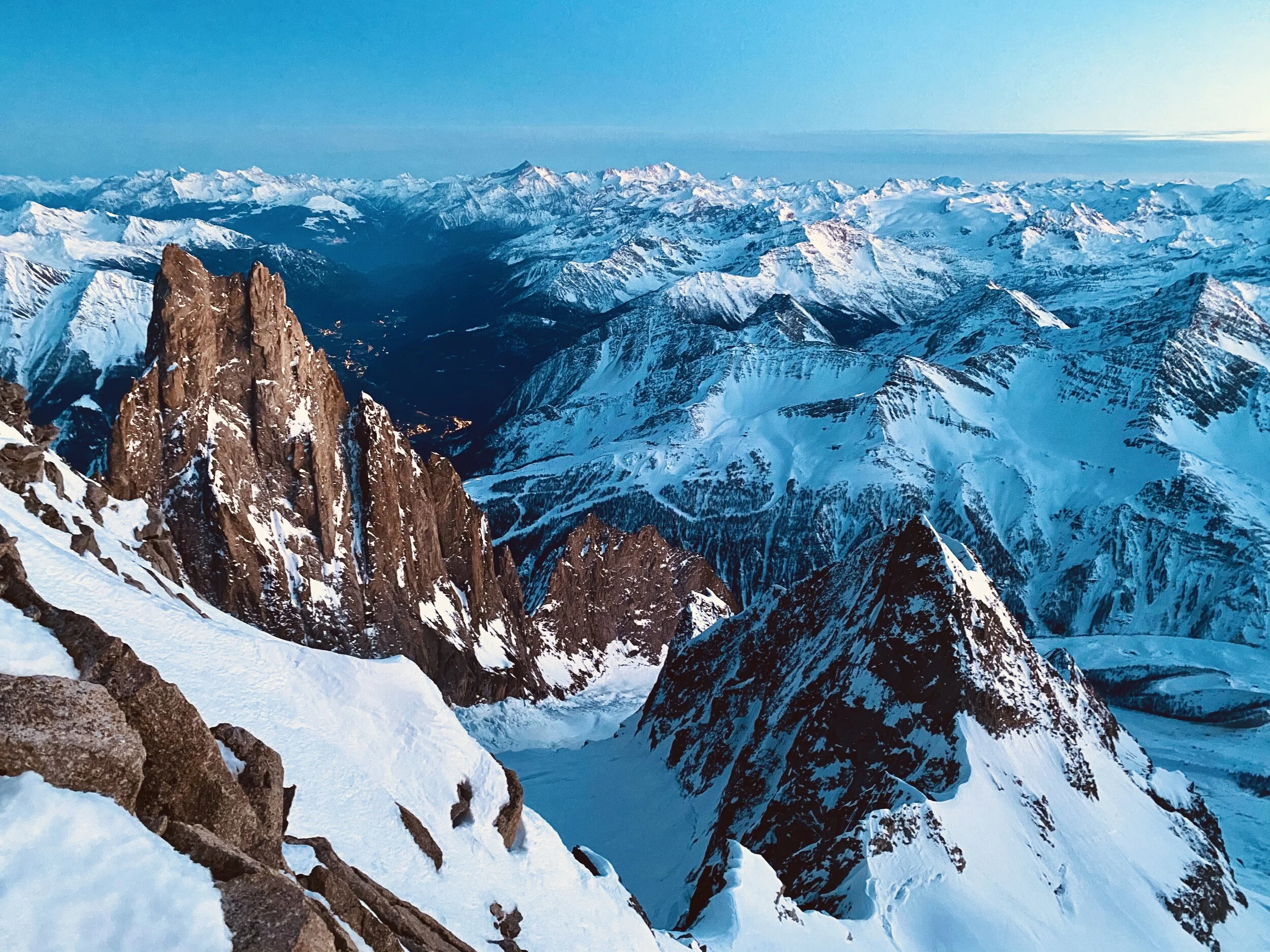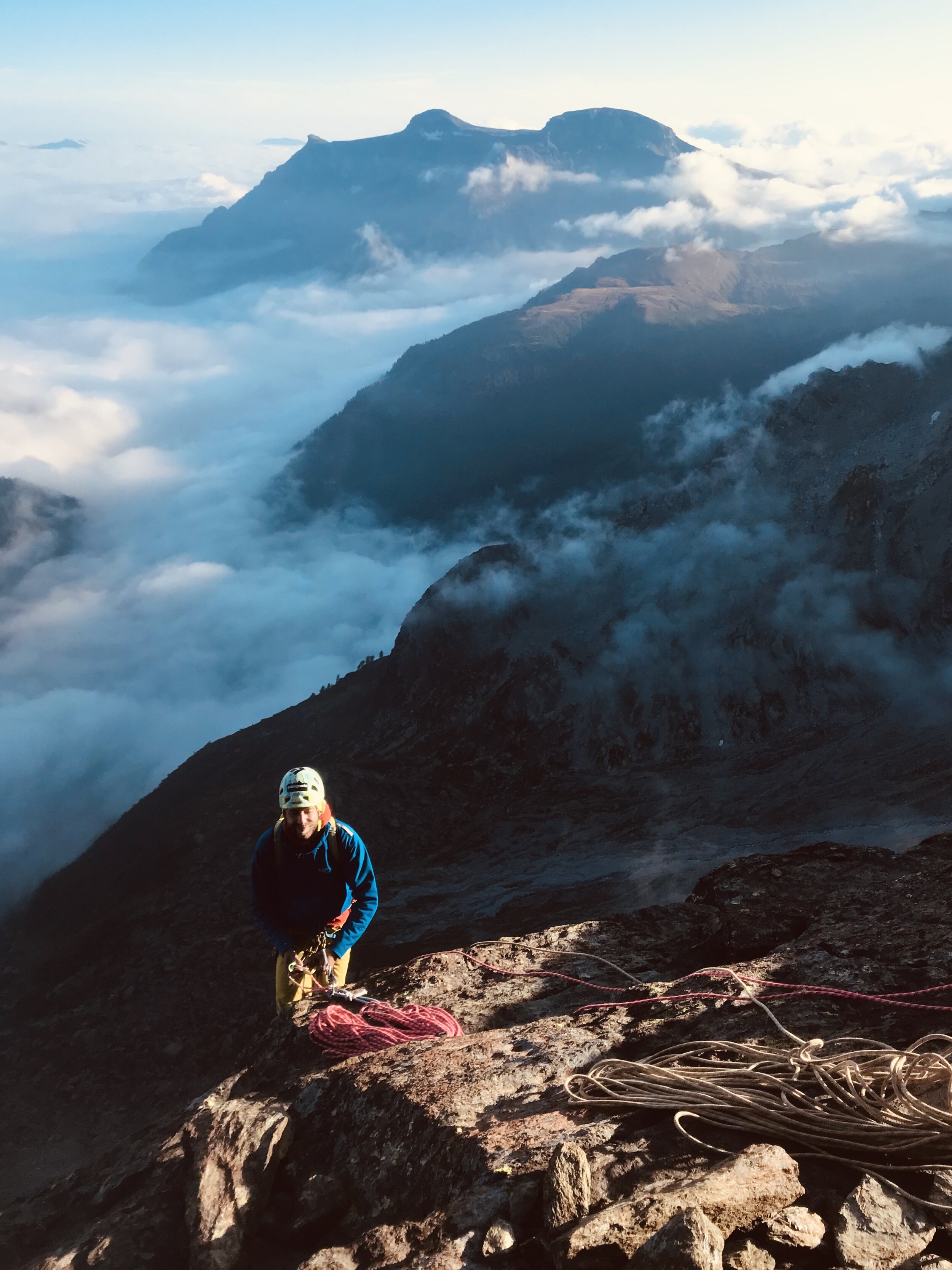90% of the job is being there
I shot this image as the first rays of sun came up. We spent a cold and sleepless night at 3000m altitude and got up when it was still dark to be in place at the right time. The previous evening I carefully scouted the location to find where the first light was coming from and how to position myself and the skier.
“If I was there at that same time, I would have taken that same photograph.”
I have heard a variation of this sentence more times that I can count. It is one of the more widespread beliefs in anyone who has a minimum of experience in outdoor photography: to get a great outdoor photograph you must be in the right place, at the right time.
Unlike many other preconceptions, this idea gets really close to reality. Outdoor photography is not taking place in a studio, where you have full control over lighting and composition. We don’t have strobes and softboxes…well, sometimes we have them too, but that’s another story. Our main light source is always either the sun or the moon; our light modifiers are clouds, fog, mountains and any other natural feature that reflect or shade the light coming from the sun. It appears obvious that we cannot move the sun as we would move a strobe on a light stand. We can’t even trim the power down one stop, or put another diffusion layer in front of it to get a softer light. We have zero control over our lighting.
So all the good outdoor photos that we see around are happening by chance? Not really. The vast majority of them comes from a savvy and accurate planning. Because it is true that we do not have the power to change anything about natural light, but it is also true that we can predict how this light will be, and when. We can know accurately where the sun will be at a given time in a given day and how the shades will fall on the landscape. By looking at weather forecasts we can understand how the sky will appear: clear, cloudy, foggy, rainy…all of these cases will affect the light quality in a different way. It is true, we do not have any chance to adjust ambient light to our needs, but with our experience we can know in advance when we will have the light we want.
Golden hour happens twice a day…we went up for the sunrise but yes, there’s also sunset. We left a bit earlier from the valley floor in order to have some spare time and make the most of the evening light.
Too often people don't realize what’s behind an outdoor photo. Between sunset and sunrise (when I shot the two images above) we spent a cold and uncomfortable night in this small shelter.
Ok, we have the light. Now what?
Another huge piece of the puzzle in outdoor photography is made by the location. Let's face it: there are places that are simply more photogenic than others. If you get up on a ridge at 4500m height in the Alps you have better chances of creating visually interesting shots than you could do in an average, flat place on the valley floor. Yes, there are some amazing photographers around who are capable of creating incredible photos almost anywhere. The chances of you being one of them are pretty low though (nor am I, at all). What we can do is to research and find mountain features, angles and point of views that we know will translate into a compelling image. These kind of locations in outdoor photography, especially on the mountains, are usually quite far from the beaten path and often really difficult to reach. The reason is simple: all the easiest and obvious spots are already over photographed. Some of those spots offer world-level views (think about Tunnel View or Glacier Point in Yosemite, Braies Lake, Seceda ridge, Trolltunga…the list is long) and they are more than worth the photos they get. The problem is that there’s not creativity anymore. Thousands of photographers are shooting that same image not because they envisioned it the same way but because they saw someone else’s work and just went there to do the same. They reverse the creative process, trying to understand what someone else already did to get that result. Although this approach is not new it has been growing tremendously in the past decade thanks to the social media and Instagram in particular. There are places so insta-famous that the trails are now eroded by the people walking there to take a snapshot…I digress, sorry.
Back on locations, since the accessible and easy to find ones are overseen, you must look further away. Be prepared to walk hours, to sleep outside, maybe to deal with technical difficulties to reach the place you choose. It is a lot of effort. And you have to do it timely, when the weather and conditions will create a light which is as close as possible to the one you envisioned.
Sometimes reaching the shooting location is much more complicated than might ever look from the final photos…
Well, you did everything right and brought back some great photographs, some that you’re proud of. When you will show them to your friends and family, there will be somebody saying that “I could have done the same if I was there.” Apart the fact that this is not true, in the sense that if you place two capable photographers in the same place at the same time they will create really different pictures, the point is another one: yes, maybe you would have taken the same image, but you were not there. You didn’t thought about shooting in that place at that time, you didn’t make the effort to get there.
In outdoor photography to set an aperture and shutter speed and to press the shutter button is only the easiest part of the job. 90% of it is knowing where and when to be in order to take a great photograph, and then to be there.
Backlight helps defining subjects. In order to have the right angle we waited for the afternoon before getting up on the wall.
Best camera for mountain photography in 2020
Zinalrothorn, Obergabelhorn, Besso and Dent Blanche at dusk. 4 seconds exposure on iPhone11 Pro.
“What camera should I buy for mountain photography?”
I can’t count how many times I’ve heard this question, and I always found difficult to reply. Every setup has pros and cons, there simply isn’t a best and a worst. Usually if you want higher quality you have to carry more weight; this makes you slower on the climb/hike, maybe so slow that you will miss the perfect moment and all that gear you carried will prove completely useless. On the other hand, you can go super light, sacrificing a bit of quality but gaining efficiency.
First abseil from Punta della Rossa, Alpe Devero, Italy. Shot on iPhone7
Over the years I’ve tried a lot of different cameras, from super lightweight compacts to bulky and super expensive medium format systems. I’ve shot amazing moments on my phone and lost the good light trying to haul 10kg of glass up on a wall. After many years of trial and errors, I finally have the answer you were looking for. It might be different from your expectations, but the good news is that you don’t need to buy anything expensive. You already have it in your pocket (or maybe in your hands).
Your smartphone camera is the best one you can carry in the mountains.
I think this can apply to most of the people you’ll find on the alpine, with the only exception being the ones who want to make big prints from those photos, but they are just a few. The majority just wants to create great photos to publish on social media, to show your friends or parents or to have memories of good times in the mountains.
Sunrise from Cresta Signal, Monte Rosa, Italy. Shot on iPhone11 Pro.
I know, you are disappointed by this statement, but I have some good reasons to say it:
today’s phones have cameras that are as good (if not better) than the first generation of DSLR. They can shoot videos and stills at outstanding quality with a good amount of control over your settings; in most cases now you can even select between multiple focal lengths, including ultra wide angles. Of course you can’t mount a 70-200 f2.8 on a phone, but the advantage of having virtually no weight (because I bet you would carry your smartphone anyway) is far greater than the limitations you get
the most important pieces of gear you will use to make a photograph are your eyes and the way you look at the world. It take a lot (and I mean a lot) of practice to push these little cameras to their limit, so before spending a fortune on a new DSLR or mirrorless kit try to improve your composition, the use of light, the way you position your subject in the frame, the moment you choose to capture. A bigger camera will give you more sharpness and more megapixels but won’t help with any of these points
one of the most challenging parts of shooting on a technical ascent is to keep your camera accessible. You don’t have the time (sometimes even the space) to take your camera from your backpack, so you must have it ready, and with a DSLR isn't always easy. On the other side, you can carry your smartphone on your chest pocket, always ready without even noticing it
by limiting your options when it comes to focal lengths and settings you will be forced to be more creative, and this will make you a better photographer. You will train your eye and your brain on how to create compelling images instead of relying on your brand new, super heavy zoom. Again, with a better camera you’ll get higher quality photos, not better photos
unless you’re really fit and constantly training for the mountains, you will want to carry the less weight possible. You’ll feel every gram, and you have to carry that backpack for many hours or even days. Does it make sense to put a couple kg of camera gear, if you’ll be too tired to take it out from your backpack when the moment will come?
View from Eccles Bivy, Mont Blanc, Italy. Shot on iPhone11 Pro.
Next time you go for a mountain mission just take your smartphone and commit to use it. Take it out when things are getting harsh - most of the best shots happens there. Use it early, while you’re running up the ridge and the first rays of sun are hitting you. Use it late, when you’ll be tired and your brain will refuse to stop for taking pictures. Shoot a lot and try to be creative. When you’ll be happy with the photos you’re taking with your phone, you’ll be ready to evolve with a bigger photo setup.
















